|
Overview of and Links to the Pages of My Community: Desert Vision - Succah
D E S E R T V I S I O N
| (1)
ALT-NEU-LAND 2003 The Midbaryah: |
(2)ALT-NEU-LAND
2003 - Gadi's and Efrat's vision "The first Midbaryah does already exist: Mitzpe-Ramon and its surroundings!" |
(3)
ALT-NEU-LAND 2003
The Pyramidion or Ohalah or Rihlah |
|
+ 2003 Sculpture completed on May 25, 2003; ~~~ 2009 Sculpture completed on July 27, 2009 |
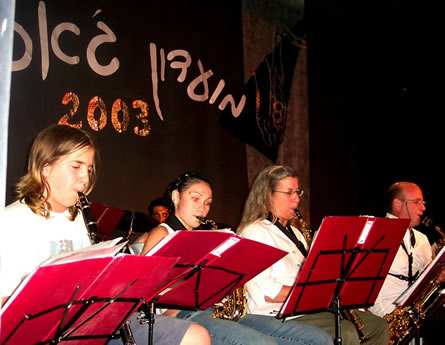
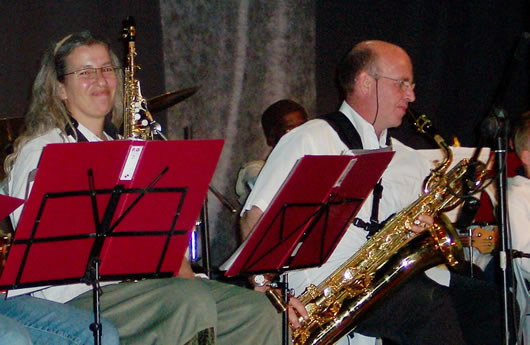
Sign of a new period : May 22, 2003
Efrat, Gadi and their son Nimrod at a Jazz concert in Mitzpe-Ramon.
The town counts 6000 inhabitants, half of them Russian immigrants,
like the musician, who founded and conducts this vibrant orchestra of amateurs.
2003_02_14; last update: 2003_05_25
I do not die, as much as I would prefer it often.
But neither has my vision for 2003 come true.
My little book hints at an another "Gulf-War",
and the fulfillment of this is all too imminent .
But my vision of people living and making a living in the desert,
needs to be either given up or deeply modified.
There is peace now
between Gadi and Avi.
But one more chapter has still to be thought through:
Not only Gadi and Efrat had to let go of the Succah.
I too have to let go - not of the Succah - as I did long ago,
but of what I had always believed to be the Succah's function.
It was Efrat, who expressed its present and probably only function.
Not a new Midbaron will be the municipal center for hosting enterprises,
but the little town, that is already in existence, Mitzpe-Ramon.
| 28.1.03 "Succah in the Desert" "Succah in the Desert" today serves
as a model for alternative tourism in the western region of Mitzpe-Ramon.
Additional sites in the region are the Alpacca Farm, "Arrow&Bow",
and the Fieldschool of Har-ha-Negev [the
highest part of the Negev]. |
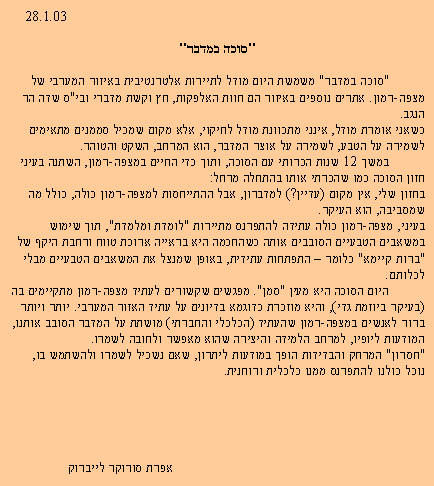 |
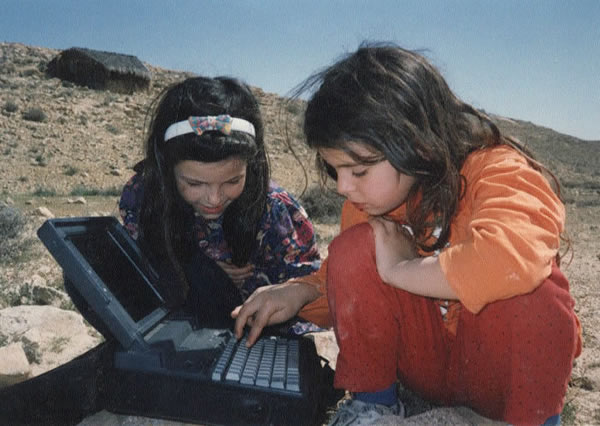 |
Another version of the photo, I let Gadi make in 1994, of Maya, his daughter, and Elah, my granddaughter, both playing with my solar powered computer on the background of "Keturah", seems to have predicted the destiny of Succah in the Desert. Keturah was the wife, Abraham took after Sarah's death. The first cabin for hosts, which we built for the first hostess, Michal Biton from Kibbutz Yif'at, in 1991, was also the only one, in which, after she left, I myself lived (for 8 months, till Renata needed it, and I returned to the bus). Then it was called "Hagar", according to the Egyptian slave, which the barren Sarah gave her husband to bear him a son. Later, when Renata had built a second cabin on the slope, this one was called Hagar and the first one renamed Keturah. It is now the one, which Avi Dror reconstructed and inhabits. The new law we made according to the Succah's new function, allows Avi to inhabit Keturah "forever", contrary to the original principle, that no one could live in "Succah in the Desert" forever. Why didn't I choose a triangular succah but a rectangular hut as representing the future Old-New-Land on the booklet? |
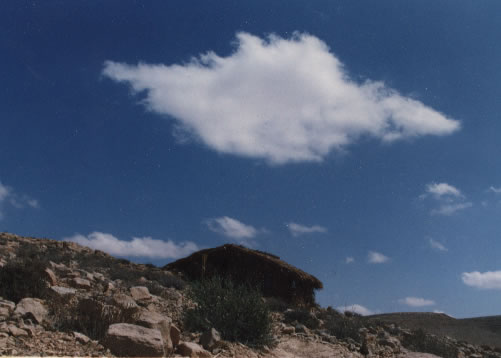 "Keturah", then called "Hagar", at the time I lived in it myself for 8 months - December 1991-July 1992 |
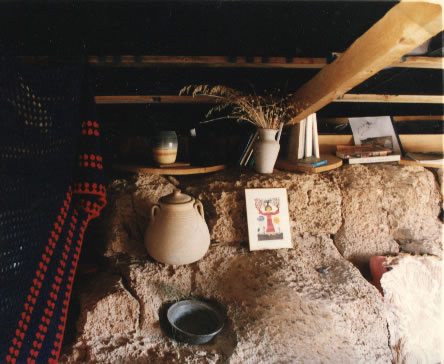 |
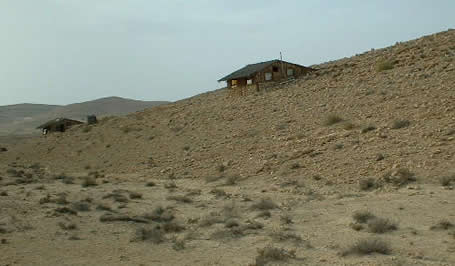 |
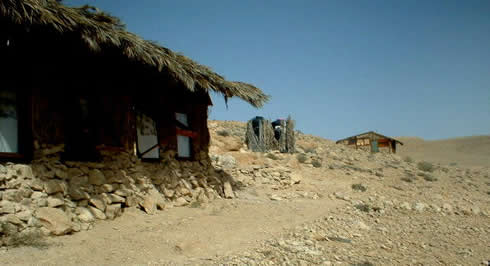 |
and only the palmfrond covered water tanks in between.
Now a new cabin-like structure - the last one, Avi promises me - is being built in between and a little above.
I differentiated between the 6 triangular "succahs" for the guests and "Abraham" - calling them according to the fathers and mothers of Israel,
and the 5 "cabins" for the hosts (Avi calls them "team workers"), in different shapes - calling them according to the serving figures in Abraham's myth.
Avi calls all 12 structures of Succah in the Desert "succahs", which is again symbolic: the "succah" is in the process of becoming a cabin, a hut.
The three structures on the one slope, towering over "Abraham",
are the sign.
They all resemble HOUSES - i.e. permanent residences - all over the planet
.
And that is, what is needed as a bridge
between the desert town Mitzpe-Ramon of the present
and the totally new form and function of any
future Ohalah/Rihlah/Pyramidion.
2003_03_01
In August 1993, Nir Gur invited the hosts to a 6 day Survival-Training.
In addition to the team of six also Gadi, Efrat and Daniela joined us.
On our way to the Judaean Desert we stopped in the town of Arad.
We were sitting at a kiosk table, when Efrat surprised me with saying:
"I feel that I am ready and mature to be the administrator
of a Midbaron."
At that time Efrat was still working and living
in the center of the city Tel-Aviv.
I want to look at the little town, which Efrat now sees as
her Midbaron.
I admit - I am prejudiced and I am judging. How could it be different?
But I hope, that some objective phenomena and facts can still be seen.
The first strange phenomenon is, that I was not out of time,
when in September 1989 I moved my bus to Mitzpe-Ramon,
or Mitzpeh, as the name is shortened by the inhabitants:
"the observation point" or "the watchtower".
There was a start-up of small enterprises,
like the Alpacca-Farm and "Desert-Shade",
to mention the two, that still survive.
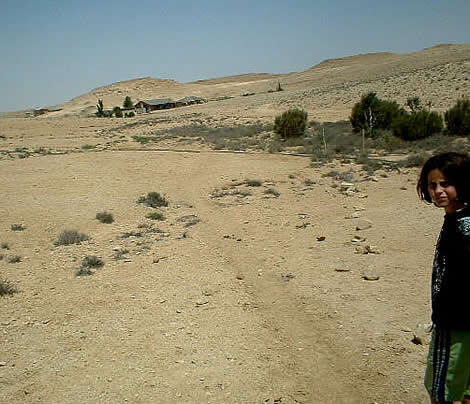 |
Inventive pioneering included also a rabbi - exactly at that time! He founded a new kind of a religious high-school at Mitzpeh, where the pupils - for instance - go out to the edge of the Crater for Kabbalat-Shabbat, the celebration of welcoming the Shabbat. He said once visited me in the Succah and said with appreciation: "The first thing a Jew does, when he comes home from Yom-Kippur (the Day of Atonement, 24 hours of fasting and praying) which is a day beyond Time, is that he hammers the first nails for his family's succah." (The Festival of Succot takes place 4 days later.) To foster the relationship, I proposed a small project to him. "Would you want to take part in making a path? Since it is so important that we all work together, I want to connect between the Succah and the Alpacca-Farm?" He really did agree, to my delight. His pupils came with me to the Alpacca-Farm, and after an introduction by Ilan himself, which to my regret was not very tolerant towards this kind of kids, they helped me to make the first kilometer of a path which - after completion - turned out to be 3,5 km long. |
|
At that time Ilan tried to keep the
Bedouin out, Now the fence is torn. |
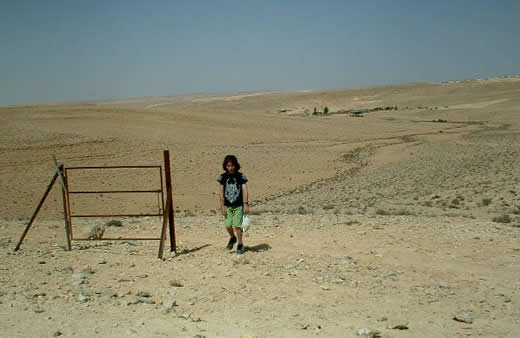 |
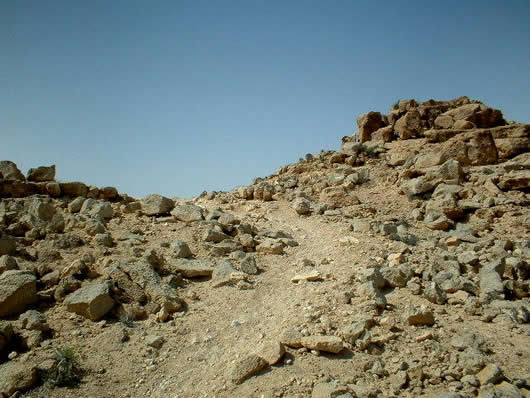 |
Past the gate and up to this ridge was the hardest part for the kids. But by then they were already quite skilled and I regretted, that they had to stop and return to other programs and that was it.. It took me and Thomas, a volunteer, many weeks to complete the path. 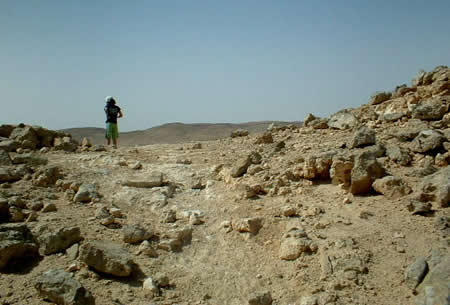
|
Another phenomenon was the gathering of Jews from France,
who are secret believers in Christ, and still lived partly in Paris.
| One of them, Itamar, a Jew, and his friend
Paul, a Christian, When the first war with Iraq "broke out"
in January 1991, |
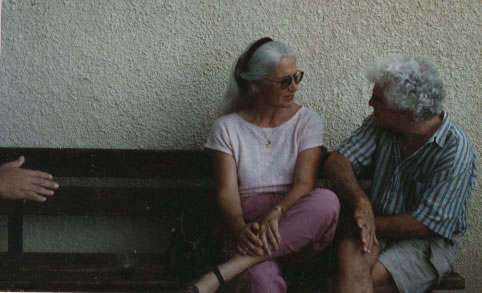 |
A third phenomenon is, that this is almost the only place
in Israel's desert,
where a - by now - branched-out Bedouin family is allowed to live legally.
Only the women still work with the sheep and goats,
the men do all kinds of jobs in and around Mitzpeh.
All through these pages I am hinting at the special relationship
I and the Succah have fostered with these men and women.
I don't know about their relationship with people in Mitzpeh itself.
As to Mitzpeh, I always used to say, that it is a microcosm
of the world.
Except for Jews from Ethiopia, who here are "replaced" by the "Black
Hebrews",
Mitzpeh has inhabitants from all nations, races and creeds.
The majority is composed of Jews from Maroccan origin and now of Russian
immigrants.
Parallel to the beginnings of the Succah, Mitzpeh's population doubled from
3000 to 6000,
A joke: "Do you know, what will be the second language
in Mitzpeh in some years?" Answer: "Hebrew".
Idealists left Mitzpeh - disappointed after many years of trying to give this
place life -
and many a new enterprise and wonderful social, artistic and touristic initiative
failed,
but Efrat says, that there is a steady influx of motivated people,
who know that it's in Mitzpe where the future is preparing itself.
Was it by chance, that on my way to completing the peace process between Gadi
and Avi,
I came in contact with two of the desert enterprises, which may symbolize
Efrat's vision?
One was with "Carmee-Ovdat", which integrates true desert agriculture
and tourism.
The other was indirect - with the Alpacca-Farm, which is focused on unique
animals,
When I traveled south to the Succah, hitchhiking as usual.
There were two among the six different drivers who had relevant information
for me.
One, a dealer with cattle, told, that lately he was buying alpaccas from the
alpacca farm.
I remembered Avi telling me, that Ilan had hardly the money for feeding his
800 animals.
"But why do you keep so many? Wouldn't 200 be enough",
said Avi and pushed him to sell.
My driver informed me:
"But Ilan sells only male animals, because he wants
to have the monopol of an alpacca farm."
It took Ilan and Na'ama many months and hardships to bring a chosen bunch
of alpaccas from the Andes to Israel,
and years, until the authorities in Israel accepted this sight in the Negev,
close to Mitzpe-Ramon (background right)
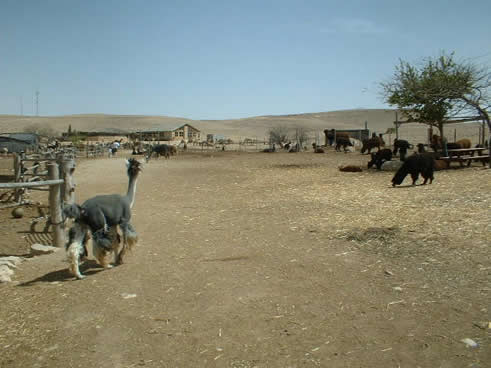 |
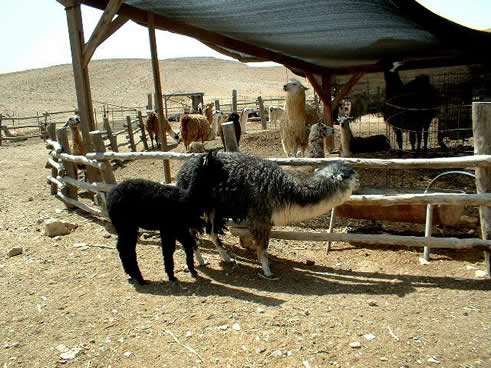 |
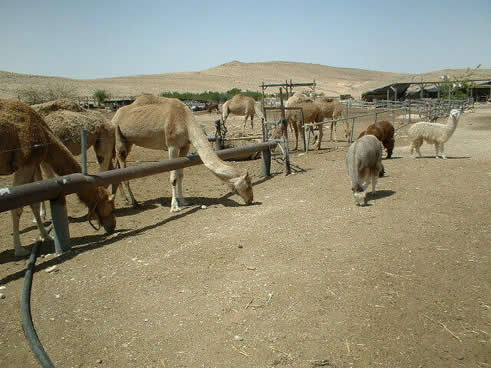 |
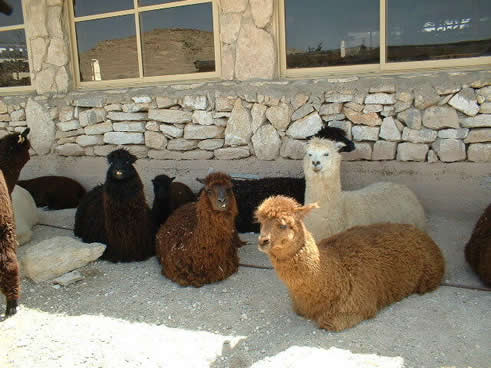 |
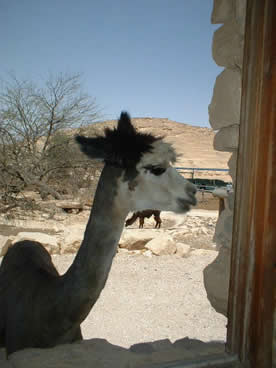 |
Like
this curious long-neck, which peeped into the window of the round stone cafeteria I wonder again about Ilan's fear of imitation and competition, and how this contradicts the principles of his fantastic creation. The Succah calls out into the deserts of the world: imitate me, let me inspire you and provides a standard for an economy, which preserves and nourishes what it is based upon: the SPS - Space-Purity-Silence - of the Desert. |
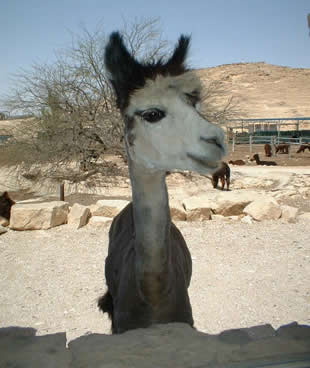 |
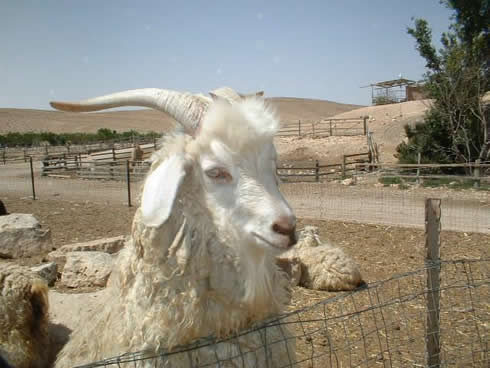 |
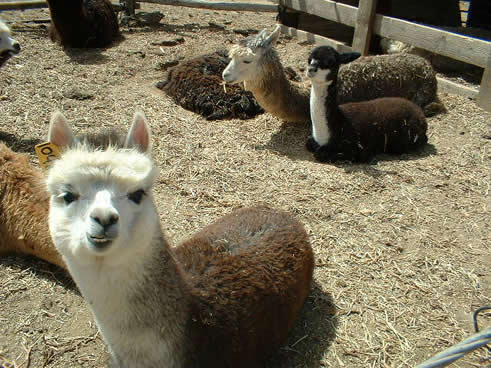 |
There's also a rare kind of goat, its horns dominating the whole desert, side by side with a little weak alpacca in the "infirmary" of the farm
 |
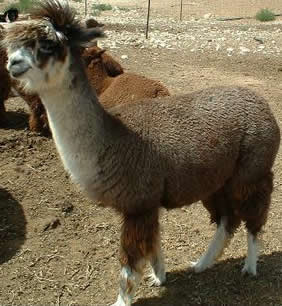 |
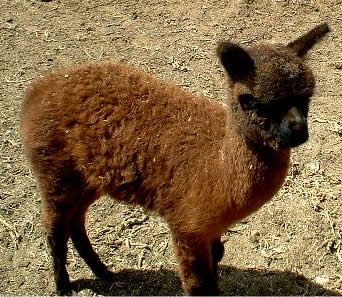 |
How unique each one looks and how human their expression is!
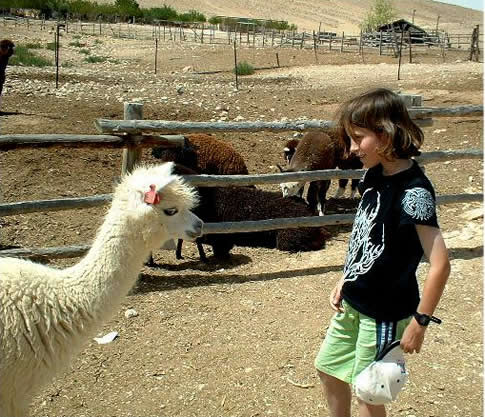 |
Among the many marvellous elements, created by Ilan and his wife Na'ama , is the possibility for people and animals to intermingle and touch. The growing delight of my grandson Jonathan in these encounters is as interesting as the background of these photos -animals inside and outside the fence, as they like. |
I hope, I'll be able to point out the enormous potential of the Alpacca-Farm,
which - like Succah in the Desert - is considered as a "unique desert
business",
but is - like Succah in the Desert - so much more.
While marvelling as always at the rock formation of the Zin wadi south of Ben Gurion College,
my next driver was a big surprise! I knew him! Eyal Yezreeli.
He was among the first
to support my desert work, but later stopped to like me.
The sun was almost setting and I was afraid to hitchhike in the dark.
But I surely needed to have a look at his wonderful enterprise:
a vinyard along a wadi with ancient Nabataean terraces,
partly watered by rain as in ancient times.
some makeshift housings for his family with 4 kids, a blacksmith workshop
and art gallery
and above - dispersed - four beautiful desert cabins, two built with adobe
and 2 little pools,
connected to an underground recycling sewage.
"How on earth did you get permission to do this?"
"The authorities have a plan to revive the Nabataean wine track,
and I slowly won them over to the combination between "green" agriculture
and "green" tourism.
Now this combination has become their standard slogan."
When I admired the luxury in the cabins, an artistic shower/bath corner, a
stereo music system, a cooking stove
and except for a TV everything that the connection to the grid (electricity
and water) allows, he said:
"Yes we never felt connected to the succahs."
To this I did not react, but kept rejoicing in the fact, that they had fulfilled
their dream.
In another context, he said: "Of course, Succah
in the Desert has become the model for what we do."
|
2009_07_26 I follow my understanding and new lekh-lekhâ on January 1, 2009, that - after 7 years - I should no longer create new pages on my 2 websites, but intermingle the evidence of new experiences with that on existing pages. Here are five inserts about Rotem's visit with Grandma in July 20-25, 2009 Arad ~~~ Mitzpe-Ramon ~~~ Arad
|
When I got
up the next morning - Wednesday, July 22 - I pondered, how I could make Rotem move her pain about the flute. The first answer I got, was: "I could buy her a new one." Perhaps her parents would agree if I told them, that because of their generous help with the payment for my teeth I had enough money to pay at least for half of a new flute. Then there came a much, much better idea! I sculpted a careful question to Gadi Lybrock and sent it as SMS: "Can it be, that your wife no longer uses the flute I gave her 7 years ago?" He consulted Efrat and called me: "Since she now plays the saxophone, [see the photos on top of this page!!!] there is no use for your flute any longer, you can have it." They invited us to come to Mitzpe-Ramon towards late afternoon. And that's how the silver flute, once used by Karl Ristenpart's son, and given to me by his sister, my oldest friend in Germany, Anke, was inherited by my granddaughter |
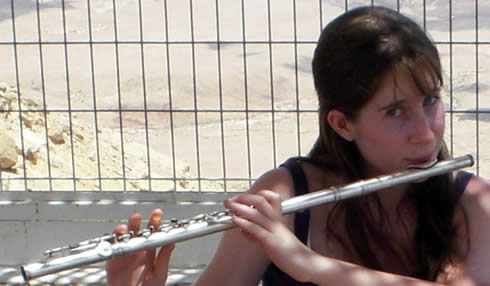 |
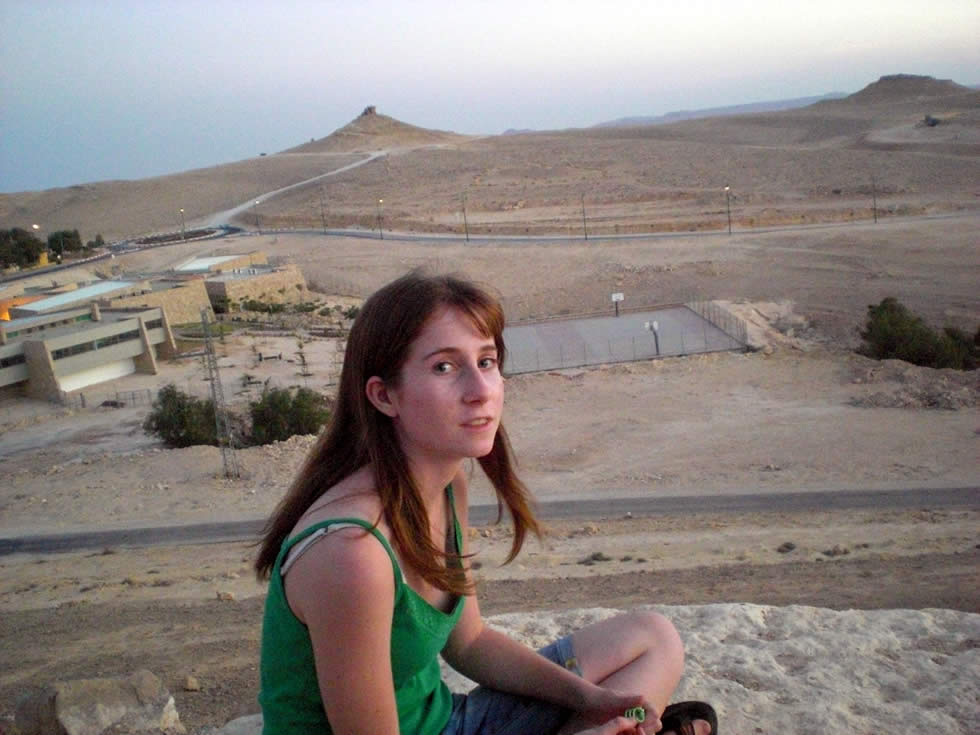
In
addition to receiving the precious flute from Efrat ("Rotem, take with you 1000 NIS from me for repairing it!"] we spent pleasant hours in the Lybrook's new home, [ which I had come to know by chance on March 14, while hitchhiking to Park Sapir>The Walk about Love], meeting the parents and all four children, even Maya. |
[Searching
for Maya's appearance on Healing-K.i.s.s., I
find in 2002: (Maya, 16, the one who stars with my granddaughter Elah on "Altneuland", was away, at a Jewish/Palestinian summercamp in Greece!) A pity Maya didn't mention this, when Rotem - now 16 - told about her participation in the Nir School of the Heart. See Maya's beauty on the photos with Tzippi: Arad, July 18, 2006 |
Since I'm so stingy now with photographing,
I documented this meeting only in two images:
Rotem sitting a few minutes away from the Lybrock house
- facing the "Camel's Mountain" on the edge of the Ramon Crater,
and the breakfast with Gadi in "The Barrel" , also on the edge of
the Crater,
to which I had invited Gadi,
"so that we can also have a talk about you and
your life and creation."
The evening and night before we were all busy with exciting
mutual updating,
also about Gadi's Ramon Jazz-Club
(see composition on top of this page)
with its formidable challenges and live-giving pleasures,
but there was no chance for deeper communication.
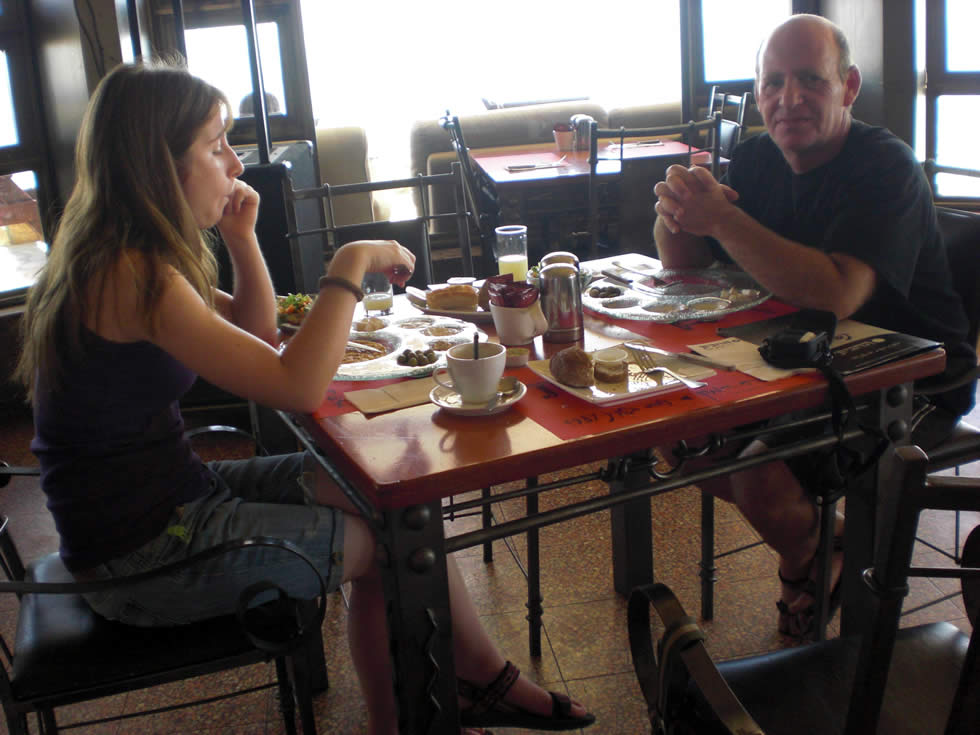
After we parted from each other, Rotem
and I roamed around on the edge of the Crater.
When we reached this spot, I was careful to get two "items" on the
picture with Rotem.
I told her the story of "Roibe",
to whose memory this observation point is dedicated,
but didn't want to overwhelm her with my story about Lewis,
the
owner of the "Isrotel" chains of hotels in Israel, most of them
in Eilat,
and whose second hotel in Mitzpe-Ramon is now being constructed "over
there".
I only said:
"In 1997 I traveled as far as to London, in order
to win over David Lewis as a partner..."
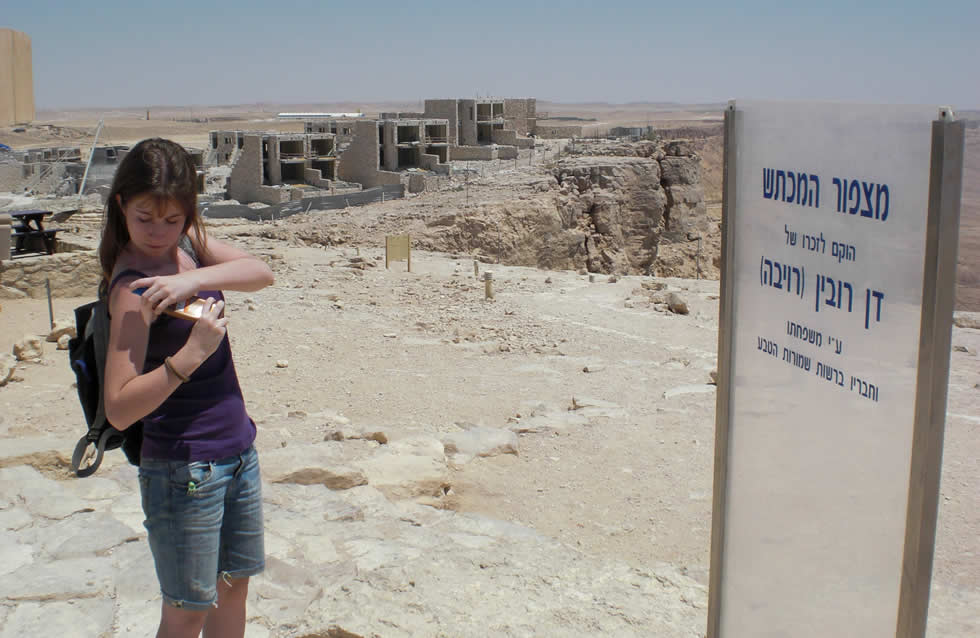
|
Continuation of the photos
of our visit to Mitzpe-Ramon see in the third insert:
|
